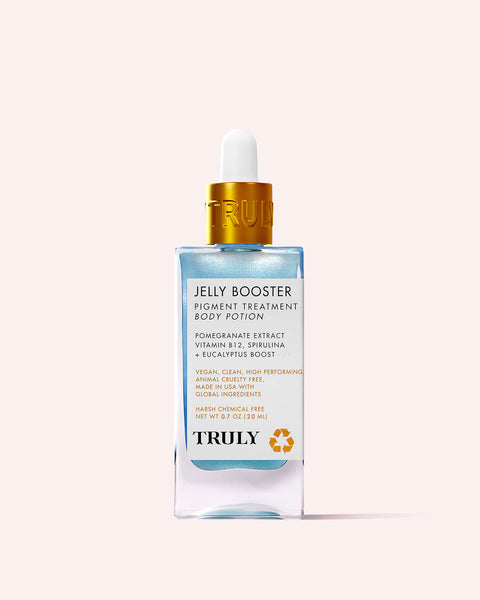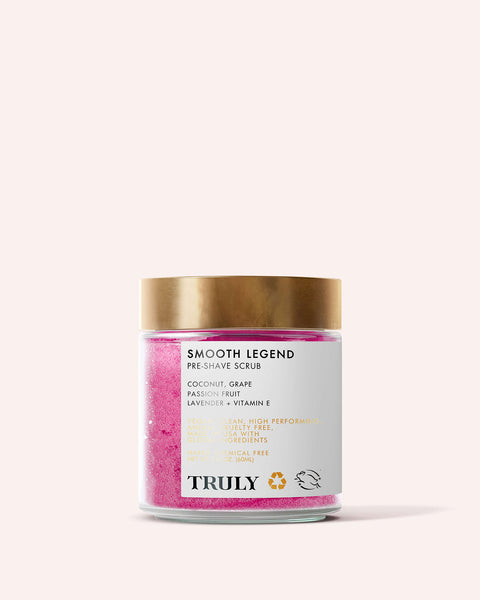Does Glycolic Acid Help With Acne?

This alpha hydroxy acid is known for its brightening and smoothing effects on the skin but does glycolic acid help with acne? Glycolic acid is an option for treating acne. Its ability to resurface, retexturize, and unclog pores means it can keep breakouts at bay and potentially even fade acne marks and scars.
Is glycolic acid good for acne? Using glycolic acid for acne might be your best option if other treatments have not worked or you're simply looking to prevent blemishes from forming. Ahead, everything you should know about glycolic acid and its effects on acne.
What is Glycolic Acid?
Glycolic acid is an alpha hydroxy acid (AHA) that exfoliates the skin’s surface to remove dead skin cells and unclog pores. Derived from sugarcane, glycolic acid has the smallest molecule size of all AHAs, meaning it can better penetrate the skin for maximum effects.
Glycolic acid can help reverse dullness by shedding dead cells to reveal fresh, glowing skin. It can also fade hyperpigmentation and acne scars by promoting cellular turnover. Alongside all of this, glycolic acid stimulates collagen production—making skin appear smoother and fine lines less visible. But does glycolic acid clear acne?
Does Glycolic Acid Help With Acne?
Yes, glycolic acid can help to improve acne and prevent future breakouts from forming. Here’s exactly how glycolic acid helps acne.
It Unclogs Pores
Breakouts typically occur when the pores become clogged with a buildup of impurities, excess sebum, and dead skin cells. Glycolic acid decongests the pores by dissolving dead cells and excess oil on the skin’s surface, preventing blackheads and whiteheads. It can even help to minimize large pores by keeping them clean.
It Combats Acne-Causing Bacteria
According to a 2020 study, glycolic acid can impede the growth of bacteria on the skin, helping to work against acne breakouts and promote a clearer complexion. The primary bacteria associated with acne is Propionibacterium acnes (P. acnes). Thanks to the bacteria-impeding activity of glycolic acid, it can directly target and kill these bacteria, preventing the formation of acne lesions.
It Promotes Cell Turnover
Glycolic acid encourages the turnover of skin cells, which means that newer, healthier skin cells replace older ones more rapidly. This can reduce the risk of acne breakouts while gradually fading the appearance of acne scars for a clearer, more even looking complexion.
It Enhances Product Penetration
By removing the outer layer of dead skin cells, glycolic acid can enhance the penetration of other skincare products, such as topical acne treatments. This can improve the effectiveness of other acne-fighting ingredients.
How to Use Glycolic Acid for Acne
You’ll find glycolic acid in many different skincare products, including cleansers, serums, and toners. Here’s the best way to use glycolic acid as an acne treatment.
1: As a Cleanser
One of the best ways to use glycolic acid for acne is as a cleanser. Cleanse your face morning and night using a glycolic acid cleanser. If you have sensitive skin, reduce this to once a day or once every two days to avoid irritating your skin. Let the product sit on your skin for a minute before rinsing off to let it penetrate your pores.
This is one of the best ways to use glycolic acid if you have sensitive skin because it doesn't stay on the skin. You get the benefits of glycolic acid for acne while being able to wash it away so you don't get too much exposure.
2: As a Serum
Serums are great for targeting specific skin concerns like acne as they contain high concentrations of active ingredients. Using glycolic acid serum for acne can help unclog pores, improve skin texture, and prevent future blemishes. It can also fade discoloration caused by acne with continued use. According to studies, glycolic acid concentrations ranging from 7% to 17% can improve the appearance of acne and scarring.
3: As a Pimple Patch
Pimple patches are a great topical treatment for acne. Unlike creams and gels, they do not rub off. Pimple patches stay in place and protect your pimple from picking fingers to prevent scarring. They harness the wound healing powers of hydrocolloid to absorb gunk and speed up healing. Some also contain other active ingredients like salicylic acid and glycolic acid to further improve acne healing.
Does glycolic acid help with acne? It certainly does, which is why you should make it part of your skincare routine. However, if you’re new to glycolic acid, make sure you start slow. Incorporate it gradually into your routine to allow your skin to adjust and avoid irritation. If you experience sensitivity, reduce the frequency of use or use a lower concentration until your skin adjusts.
Best Glycolic Acid Products for Acne
We’ve rounded up the best bundles featuring glycolic acid and other powerhouse ingredients for targeting acne. Take a look, and give one of these acne-fighting sets a try.
Truly’s Super Star Routine
SHOP NOW
Restore clear, luminous skin with this 3-step routine. You get: a face mask, serum, and pimple patches that work together to clear pores and combat acne. Formulated with glycolic acid and retinol to resurface, decongest, and renew plus vitamin C to fade discoloration and leave skin glowing.
Truly’s The 3-in-1 Routine
SHOP NOW
Melt away dead cells and impurities while buffing your way to bright, clarified skin. The 3-in-1 routine contains a scrub, polish, and heart pimple patches to leave you clearer in three. Use on both your face and body to target acne wherever (and whenever) it strikes. Powered by glycolic acid, retinol, and hydrocolloid.
Truly’s Bodne Routine
SHOP NOW
Get your hands on our award-winning bacne cleanser along with three other bestsellers for combating body acne. What’s inside? A body cleanser, lotion, mist, and pimple patches infused with AHAs, BHAs, and niacinamide to leave skin clear, smooth, and soothed all over.
How Long Does it Take for Glycolic Acid to Clear Acne?
According to dermatologists, you should notice clearer skin after about a month of using glycolic acid on a regular basis. Three months in, you should see that acne marks and discoloration are reduced as regular glycolic acid use melts away dead cells and spurs cell turnover.
To get the best results from glycolic acid for acne, make sure you use it regularly and consistently. Most skin types will be able to tolerate daily use of this AHA. Those with dry or sensitive skin may benefit from using it every other day to avoid dryness and skin irritation.
Side Effects of Glycolic Acid for Acne
Some of the most common side effects of glycolic acid include dry skin, itching, and irritation. Those with dry skin or sensitive skin are more likely to experience these side effects. Glycolic acid can also make the skin more sensitive to sunlight, which is why it’s essential to use sunscreen after using.
Should You Use Glycolic Acid for Acne?
Glycolic acid is a powerhouse ingredient that’s typically used to target uneven skin tone and texture. It can also be an effective acne treatment thanks to its ability to penetrate clogged pores and fight acne-causing bacteria.
Does glycolic acid help with acne? Most people with acne-prone skin can benefit from using glycolic acid in their daily skincare routine. It helps keep pores clear and prevents the buildup of excess sebum to stop blemishes from forming.
That being said, if you have severe acne, you may need another treatment in conjunction such as salicylic acid or benzoyl peroxide. Nevertheless, glycolic acid can be helpful at unclogging pores, preventing breakouts, and fading discoloration associated with acne.
Photo by Karolina Grabowska, Pexels



























































